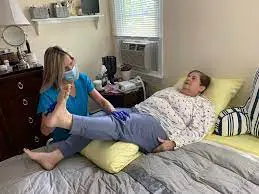Home Healthcare Physical Therapy
What is Home Healthcare Physical Therapy?
- Giving patients the tools to take care of their illnesses independently is the goal of at-home physical therapy. Physical therapists provide the skills you need to take charge of your treatment or recuperation. You learn how to utilize tools and equipment that are easily accessible in your own home when you receive physical therapy as part of home health care.
- You could profit from the expert services of a physical therapist if you have an issue that causes discomfort or a loss of functional mobility. The goal of your therapy will be to help you regain your usual range of motion so you may resume your favorite activities.
- Care for physical therapists may be given in many different places. Naturally, if you are admitted to the hospital, a physical therapist employed by the facility may administer your treatment. You can visit an outpatient physical therapy center if you need sports treatment.
- It might be challenging for certain individuals to leave their homes and go for physical treatment. These individuals could still benefit from in-home physical treatment. They could receive home visits from a physical therapist who will assist them in regaining their regular range of motion.
What is in-home physical therapy (PT) and how can it help you at home?
What to Expect From Physical Therapy?
- In-home care Physical therapy is receiving rehabilitation services from a physical therapist who visits your house. Patients who cannot leave their homes to attend physical therapy are eligible for this kind of care. This might occur for some reasons, including:
- You pose a health risk when you leave the house because of your acute or severe disease.
- You are unable to travel for therapy and have limited functional mobility.
- You don’t have access to or enough transportation to get to your physical therapy appointments.
- All you want is a home-based private physical therapy session.
- For your insurance company to pay for home-care physical therapy, there are specific guidelines that must be followed. The majority of physical therapy treatments provided in the US are covered by insurance.
- Physical treatment in your home, if you can show that you have major hurdles to leaving your home, will be covered by most insurance policies. These obstacles can result from your sickness or injury or from your incapacity to travel.
- Your insurance company might not pay for physical therapy if you decide to receive it at home only because it is more convenient for you. In this case, you will be responsible for paying for the therapy yourself.
How Do You Get In-Home PT?
- PT may be helpful if you have a disease or condition that prevents you from moving around as you typically would. Additionally, home-care physical therapy can be your best option if you are unable to leave the house.
- The majority of individuals who get physical therapy at home are recommended to the program by their physician. Your doctor can vouch for the medical necessity of home services and refer you to a nearby visiting nurse program that provides physical therapy. Probably, this medical necessity report will further specify that you require home-care physical therapy because your circumstances or condition prevent you from leaving your home.
- You may also give your neighborhood physical therapy clinic or visiting nurse association a call if you think you would benefit from receiving physical therapy at home. These organizations can guide you through the process of getting physical therapy at home.
Who Can Benefit From It?
- So how do you decide if physical treatment at home is good for you? In general, working with a physical therapist may be beneficial if you have any issues that cause you to lose functional mobility. And a PT can visit your home if you are having trouble leaving there. Physical therapy for home care may be necessary for the following conditions:
- problems following surgery, such as complete knee or hip replacements
- Stroke
- Parkinson’s disease
- Multiple sclerosis
- Amyotrophic lateral sclerosis (ALS)
- After trauma such as a fracture
- If you have a disease that makes it difficult for you to move around regularly and if you find it difficult to leave your home for treatments, in-home rehab might be helpful.
What If I Don’t Qualify?
- Patients occasionally request home-care physical treatment, but their insurance company refuses to pay for it. This might occur if your insurance provider decides that in-home physical treatment is unnecessary for your condition. It can also happen if you haven’t demonstrated that you are unable to leave your house or if traveling for physical therapy would put a heavy load on you.
- Should home-care services be refused, you might be able to file an appeal. Ask about an appeals process when you give your insurance provider a call. You could also choose to describe your circumstances over the phone to the office of your healthcare practitioner. You could get assistance from your healthcare professional in navigating the appeals process.
- You can see a local outpatient clinic for physical therapy if you are not eligible for home-care PT. Naturally, receiving treatment at the facility will require travel. To help you reduce the number of times you visit their facility for treatment, your outpatient physical therapist should be able to provide you with exercises to perform at home.
- If you are not eligible for services, you can potentially choose to just hire a private home-care physical therapist to visit you at your home. This alternative, though, can be expensive.
Is In-Home PT Effective?
- A common question is whether home-care physical therapy works. Why? Because a lot of people think that participating in a successful rehabilitation program requires pricey, bulky workout equipment and gear. This isn’t always accurate. Your physical therapist for at-home treatment is skilled in making the most of the resources at hand to enhance your rehabilitation process. To make sure you get the most out of your physical treatment, he or she can also provide lightweight equipment to your house.
- A 2016 research that looked at patients’ functional outcomes following total knee replacement surgery was published in the journal Orthopaedic Nursing. While some research participants received outpatient physical therapy in addition to home-care physical therapy, others saw outpatient PT exclusively. The study’s authors observed no differences when comparing function and range of motion (ROM) measurements between the two groups. After a knee replacement, physical therapy at home did not significantly improve outcomes, but it also did not have a detrimental effect.
- After receiving in-home therapy treatments, individuals with upper extremity hemiparesis and weakness following a stroke reported better outcomes and higher levels of satisfaction with their care. Since there were just six patients in this trial, its power is deemed to be low. Nevertheless, research suggests that home-care physical therapy might have some advantages.
- It would be best if you healed while receiving physical treatment at home. Your functional mobility may also improve as your condition gets better, and you might be able to start going out of the house more frequently. Your home-care physical therapist could stop providing in-home services if this occurs. You might then proceed with your recovery at an outpatient physical therapy facility.
Conditions Treated with Physiotherapy at Home:
- Many medical disorders may be treated with at-home physical therapy, which aids patients in regaining their strength, flexibility, and functioning. Home-based physical therapy is frequently used to address the following conditions:
Post-Surgery Rehabilitation:
- Physical therapy can help with mobility return, pain management, and muscular strength restoration following surgery.
Chronic Pain Management:
- Specialized workouts and therapies can help people with chronic pain disorders manage their pain successfully.
Mobility Issues and Balance Disorders:
- Those who struggle with mobility can restore their ability to walk around and carry out everyday tasks safely with physical therapy.
Recovery from Injuries:
- Physical therapy can aid in the healing process following an accident or sports injury by encouraging healing and averting other issues.
The Advantages of Home-Based Physiotherapy:
- The benefits of home-based physical treatment are numerous and have led to its growing acceptance.
Convenience and Comfort:
- More comfort and convenience for the patient results in improved compliance and outcomes.
Cost-Effectiveness:
- A more affordable option for extended hospital stays or regular clinic visits is home healthcare.
Personalized Care and Individual Attention:
- Individualized care and one-on-one attention are provided to patients, who have specific needs and objectives to be met.
Some Advice for Getting the Most Out of Home Physiotherapy
- To maximize the benefits of physical therapy at home, patients and those providing treatment can apply the following advice:
Create a Dedicated Therapy Space:
- Set up a special space at home, away from distractions and dangers, for treatment sessions.
Stick to the Treatment Plan:
- Maintaining consistency is essential; following the recommended treatment plan will improve outcomes.
Involve Family Members or Caregivers:
- Include carers or family members in the therapeutic process to offer encouragement and support.
Maintain Open Communication with the Therapist:
- Keeping lines of communication open with the physical therapist guarantees that issues are resolved quickly.
Conditions Treated with Physiotherapy at Home:
- Many medical disorders may be treated with at-home physical therapy, which aids patients in regaining their strength, flexibility, and functioning. Home-based physical therapy is frequently used to address the following conditions:
Post-Surgery Rehabilitation:
- Physical therapy can help with mobility return, pain management, and muscular strength restoration following surgery.
Chronic Pain Management:
- Specialized workouts and therapies can help people with chronic pain disorders manage their pain successfully.
Mobility Issues and Balance Disorders:
- Those who struggle with mobility can restore their ability to walk around and carry out everyday tasks safely with the aid of physical therapy.
Recovery from Injuries:
- Physical therapy can aid in the healing process following an accident or sports injury by encouraging healing and averting other issues.
The Advantages of Home-Based Physiotherapy:
- The benefits of home-based physical treatment are numerous and have led to its growing acceptance.
Convenience and Comfort:
- More comfort and convenience for the patient results in improved compliance and outcomes.
Cost-Effectiveness
- A more affordable option for extended hospital stays or regular clinic visits is home healthcare.
Personalized Care and Individual Attention:
- Individualized care and one-on-one attention are provided to patients, who have specific needs and objectives to be met.
Summary
- Giving patients the tools to take care of their illnesses independently is the goal of at-home physical therapy. Physical therapists provide you with the skills you need to take charge of your treatment or recuperation. You learn how to utilize tools and equipment that are easily accessible in your own home when you receive physical therapy as part of home health care.
- You could profit from the expert services of a physical therapist if you have an issue that causes discomfort or a loss of functional mobility. The goal of your therapy will be to help you regain your usual range of motion so you may resume your favorite activities.
- Care for physical therapists may be given in many different places. Naturally, if you are admitted to the hospital, a physical therapist employed by the facility may administer your treatment. You can visit an outpatient physical therapy center if you need sports treatment.
- It might be challenging for certain individuals to leave their homes and go for physical treatment. These individuals could still benefit from in-home physical treatment. They could receive home visits from a physical therapist who will assist them in regaining their regular range of motion.
FAQ
Does home treatment work well?
A modest 2016 research found that physical treatment at home could be just as successful as therapy in an office. There was no discernible difference in the total functional recovery after knee surgery between individuals treated in the office and those treated at home, according to the research. It was noted by the research that in-office functional benefits occurred sooner.
What does home treatment mean?
Home-based counseling, home-based psychotherapy, and in-home treatment are alternate names for home-based therapy. It happens when a person receives counseling from a therapist in their house. Many people’s treatment goals have been achieved with the aid of home-based therapy.
Is home physiotherapy a possibility?
Indeed. But there’s a catch to that answer. Your at-home physical therapy routine is probably not going to be very successful if all you plan to do is seek up a lot of exercises online and attempt to execute them whenever you can find the time. Physical therapy is helpful for many different diseases and injuries.
Do I need physical therapy to heal?
Your recuperation may be seriously hampered if you stop doing physical therapy or don’t finish your course of treatment. The absence of physical therapy may result in Reduced blood supply to the surgery site, which may cause the healing process to take longer. muscular atrophy or weakness.
Is daily physiotherapy okay?
It may be necessary for you to attend physical therapy on consecutive days depending on your health and the duration of your treatment. While some people might find it beneficial to skip breaks in between sessions, others might need them to prevent burnout. Always heed your therapist’s suggestions regarding what is most effective for you.







